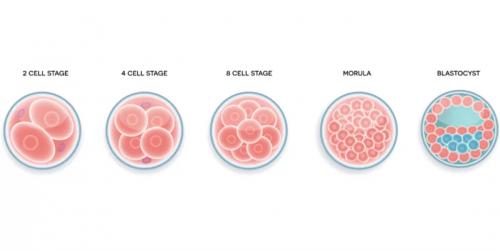Embryo Grading and Success Rates

For hopeful parents undergoing In Vitro Fertilization (IVF), understanding the tiny miracles growing within the lab setting can be both fascinating and anxiety-inducing. One important step of this journey is embryo selection and this happens most commonly by grading the embryos and choosing the best ones for transfer to ascertain the likelihood of a healthy pregnancy.
This grading is often performed on the third and fifth days after the eggs are extracted and fertilized, and it helps in determining the embryo quality and the best timing for their transfer. However, how is embryo grading done, and what is its impact on the success rate of IVF treatment? Let’s see.
Embryo Formation and Development: From Single Cell to Blastocyst
The magic of life begins with a single sperm fertilizing an egg. Over the next few days, this microscopic cell starts dividing repeatedly, reaching the cleavage stage by day 2 with 4 cells each followed by 8 cell stage on Day 3. These rapidly dividing cells, called blastomeres, hope to become a baby.
Around day 5, the embryo develops into a complex structure known as a blastocyst, which resembles a hollow ball with two separate sections: the inner cell mass (ICM), which will eventually form the baby, and the trophoblast (a thin layer of cells which helps in implantation and placenta development).
Embryo Grading System
Now, let’s move to the main topic: embryo grading.
Embryo grading isn't about picking a favourite one; it's a critical evaluation of embryo quality performed by embryologists to determine an Embryo's health, viability and pregnancy potential. This grading system is uniformly followed across the globe according to the consensus guidelines laid down by experts and based on their scientific data and their experiences.
Cleavage Stage Embryos (Day 3): At this stage, the embryo is graded based on cell number, symmetry, and degree of fragmentation. The table below can help you to understand better:
Factor | Grade A | Grade B | Grade C |
Number of Cells | 7-9, evenly spaced | 6-7 cells, slightly uneven | Less than 6 cells, uneven |
Fragmentation | Less than 10% | 10-25% | Over 25% |
Live Birth Rate | 40-50% | 25-40% | 15-25% |
Note: The live birth is an estimation. It can vary depending on several factors, including age, lifestyle, overall health and other factors.
Blastocyst Stage Embryos (Day 5): For a day 5 embryo, grading is done based on the development of the inner cell mass (ICM), the trophectoderm (TE), and the degree of expansion to ensure IVF success rate. Let’s understand it with the following tables:
Table 1:
Blastocyst Grade | Blastocyst Stage | Description |
Grade 1 | Early Blastocyst | Blastocoel volume is less than half that of the embryo. |
Grade 2 | Blastocyst | The blastocyst cavity is more than or equivalent to half the volume of the embryo. |
Grade 3 | Full Blastocyst | The blastocyst cavity fills the embryo. |
Grade 4 | Expanded Blastocyst | The blastocyst cavity is greater than the early embryo, and the surrounding membrane is thinning. |
Grade 5 | Hatching Blastocyst | The outer layer of cells had begun to rupture through the surrounding membrane. |
Grade 6 | Hatched Blastocyst | The blastocyst has fully ruptured. |
Table 2:
Blastocyst Grade | Inner Cell Mass (ICM) | Trophectoderm (outer layer) |
Grade A | Tightly packed, many cells | Many organized cells, even thickness |
Grade B | Loosely packed, few cells | Fewer cells, uneven thickness |
Grade C | Very few cells | Very few cells |
Impact of Grading on IVF Success Rates
In the context of your IVF journey, the development and health of blastocysts play an important role in the likelihood of achieving a successful pregnancy. According to the studies, using blastocysts of high quality (for instance, those graded higher than 3AA, 4AA), the IVF success rate is approximately 65%. When embryos are of average quality, such as grades 4BB, 4AC, 4CA, 2AB, or 2BA, the likelihood of pregnancy drops to around 45%. On the other hand, transfers involving lower-quality blastocysts (grades like 3BC, 4CB, 4CC, and 2BB) see a further reduced pregnancy rate, coming in at about 20%.
So, let’s understand it with the help of the table:
Embryo Quality | Embryo Grade | Pregnancy Rate | Live Birth Rate |
Excellent | 3AA, 4AA, 5AA | 65% | 50% |
Good | 3AB, 4AB, 5AB, 6AB, 4BA, 5BA, 6BA | 55% | 40% |
Average | 3BB, 4BB, 5BB, 6BB | 30% | 20% |
Poor | 4BC, 5BC, 6BC, 4CB, 5CB, 6CB | 10% | 5% |
The best IVF centre in Delhi prefers to transfer the best possible embryos, ideally high-grade blastocysts. However, they consider individual circumstances. For women with lower egg reserves or limited blastocyst formation, day 3 embryos with good grades might be an option.
Wrapping Up!
Embryo grading in IVF is like having insider knowledge on which embryo will grow into a baby. Knowing this simplifies the IVF journey, offering clarity and hope.
Remember, while not every high-grade embryo leads to pregnancy, and not every lower-grade embryo is out of the race, having this knowledge about embryo quality empowers you to make informed decisions.
If you are looking for IVF treatment with a high success rate, consult Dr Rhythm Gupta. She will guide you through the embryo grading process so that you can enjoy your fertility journey.
Post Your Ad Here
Comments